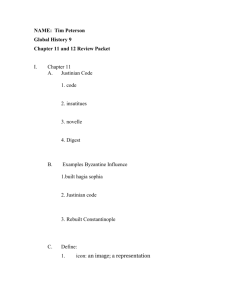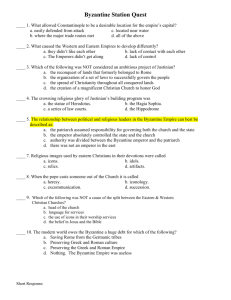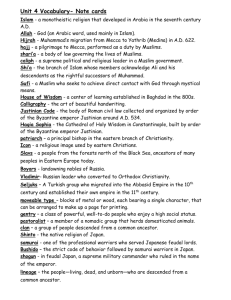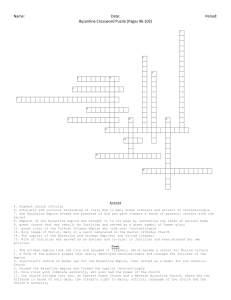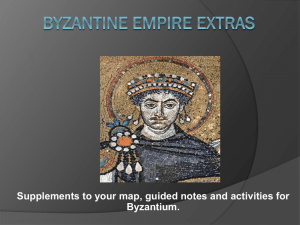Byzantine Empire: Justinian, Hagia Sophia & More
advertisement
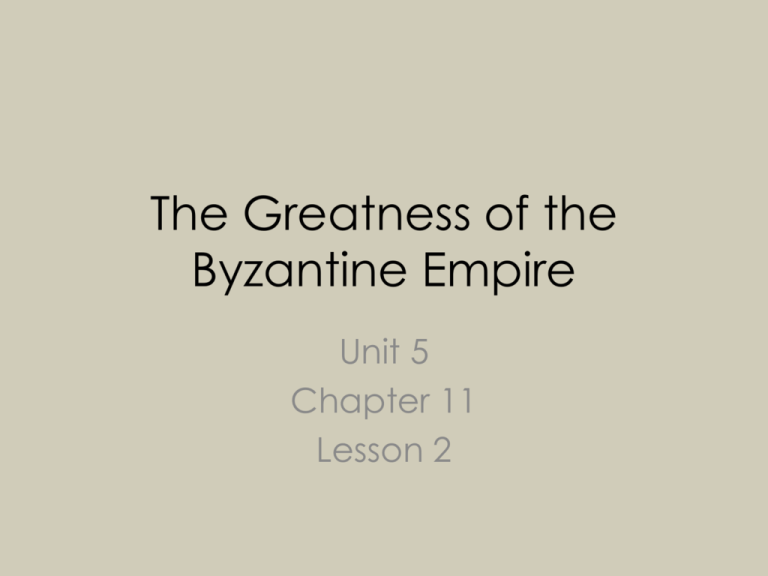
The Greatness of the Byzantine Empire Unit 5 Chapter 11 Lesson 2 Vocabulary • Justinian I - Emperor of Byzantine Empire 527-565 CE • Cathedral - Large important Christian church • Hagia Sophia- Cathedral in Constantinople • Constantinople -Capital of Byzantine Empire • Theodora- Empress of Byzantine Empire • Justinian Code- Set of Laws • Icon- Religious picture of Jesus and saints Constantinople • • • Formerly Byzantium named after Constantine Capitol of Byzantine Empire Hagia Sophia • • rebuilt by Emperor Justinian I after destroyed in riots Hagia Sophia means Church of Holy Wisdom of God in Greek Hagia = Holy • • Sophia = Wisdom Located in Constantinople Largest Cathedral in world for nearly 1,000 years Painting depicting Construction of Hagia Sophia during reign of Justinian Hagia Sophia then Hagia Sepia now Hagia Sophia became an Islamic Mosque, today it is Museum Interior of Hagia Sophia by John Singer Sargent 1891 CE All Byzantine Cathedrals were decorated in great detail Jesus Mosaic, one of many that have been uncovered in modern times 527 CE Justinian I ascended to the Byzantine throne • Wanted to restore the Roman Empire • Wanted to govern it as a whole • Paid Persian Kings to stop threatening the far western part of Asia – • Far Eastern Part of Byzantine Empire • Strong army conquered • • • • • Many lands lost by Rome Mediterranean Islands N. Africa - Vandals Italy - Ostrogoths Spain - Visigoths Coin commemorating Justinian's re-conquests of Africa, c. 535 The Byzantine Empire of Justinian’s Reign Purple = size of Empire when Justinian came to power Orange = lands conquered by Justinian Theodora & Justinian • Was a commoner – A circus performer in the Hippodrome – Dad was a bear trainer • Most trusted advisor – Intelligent – political wisdom – Street smart • Told Justinian to defend city against attack in 532 C.E. • Government jobs based on ability not social class Justinian Code • Wanted to organize laws • Made empire operate smoothly • 10 men review 1,600 books of Roman Law to create simpler laws • Men created Justinian Code • 4,000 Laws in 4 books • Many legal systems today based on code – One of the laws in Justinian Code stated that a person was innocent until proven guilty • Many laws reflect Theodora’s view of treating women more fairly Mosaic of Justinian as law-giver from San Vitale of Ravenna Cathedral Architecture very important to show power of the Empire New harbors Aqueducts Cisterns Churches Interior & Bell Tower at St. Vitale Ravenna Valens Aqueduct in Constantinople Byzantine Art Pair of Jeweled bracelets 500-700CE flask with the adoration of the Magi 500-550CE Portrait bust of Woman with a scroll late 4th-early 5th Century Two Panels of an Ivory Diptych Announcing the Consulship of Justinian, 521CE Fragment of a Floor Mosaic with a Personification of Ktisis, 500–550 Strong Ties between Church & Emperor Justinian I • Byzantine Orthodox Church the Official Church • Church controlled political and cultural life • Justinian believed God chose him to run the Empire • Justinian built the Hagia Sophia to cement relationship between Church and Emperor Religious Icons • Pictures or images of Jesus & Saints – – – – – 2 dimensional Appear flat Face front Large eyes Reverse viewpoint • From God’s Perspective not viewer” Perspective • God is looking out of picture at viewer – Used as a form of prayer • Use of Icons helped lead to schism between Byzantine Orthodox and Roman Catholic Church in1054 Mary and Jesus Icon Naturalistic vs. Iconic Art Syric Bible illumination depicting Job vs. Icon of St. Columba End of the Empire • • • Byzantine Empire lasted 500 years 1000 CE empire began to weaken 1054 CE Roman Catholic Church and Eastern Orthodox Church Schism (split)

